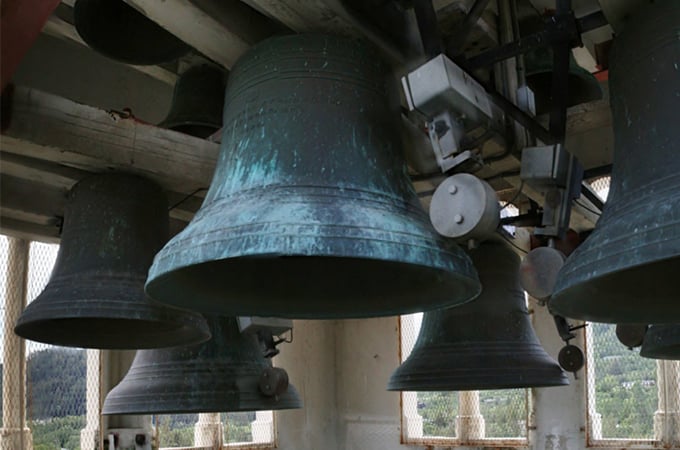In my role as a Ford Fellow at the U of R Graduate School of Theology (GST), I research and teach about ritual studies, an interdisciplinary field that encompasses the worship rituals of faith traditions, but also simply the ritual behavior of humans themselves.
Ritual has been important in navigating change and crisis as long as humans have been humans. When a society becomes ritually impoverished, its members have diminished access to practices that help us share deeply and express our deepest pain and joy—whether that is in breaking bread together physically, sending a sympathy card, or sitting with loved ones as they pass over. In times of crisis, we can feel we are without the means for connection, an antidote to anxiety.
And the COVID-19 pandemic is definitely a crisis. Yet with it, I have seen a surge in ritual activity that has arisen to fill the gaps, in both institutional religious activity and society at large. Much ink has been spilled over the definition of “ritual,” but I would say it can be defined simply as intentional activity "during crucial times in founded places” (as scholar Ronald Grimes would say), especially engaging persons at times of heightened “receptivity,” such as during a crisis.
I taught a course last year at the GST called “Rituals with Nones, Dones, and SBNRs (Spiritual-But-Not-Religious),” and the creativity of the students in their projects was incredibly exciting as they worked to ascertain the ritual needs in an increasingly secular society. I see this indelible creative human spirit and penchant for ritual arising now in response to COVID-19:
- In Redlands, Mayor Paul Foster, the Redlands Area Interfaith Council, and the Redlands Service Club Council recently invited residents to join the city and local churches in a “Moment at 7” honoring health-care workers, first responders, grocery store workers, and other helpers every Sunday at 7 p.m. until the end of May. While residents go outside and ring bells, sound gongs, and cheer, local churches ring their bells and police and firefighters flash their lights and sound their sirens in appreciation. In New York City, this ritual is taking place every night at 7 p.m. In Marin County, the bells on our campus add to a sonic sign of gratitude and communal support involving howling, clapping, and singing every night.
- People in British Columbia are creating hearts to hang in windows, illuminate office buildings, or paint on roofs to say “thank you” to those who risking their health to care for others. This sentiment takes other forms in other places, such as Teddy Bears in Australia and New Zealand, rainbows in the U.K., white ribbons around trees in the U.S., flowers and sidewalk chalk affirmations at the doors of hospitals. These and other visual symbols help create community in the absence of physical gathering.
- Parents are organizing birthday celebration “parades,” as neighbors come out on their doorsteps to cheer at a prescribed hour. I even heard of neighbors who found out a wedding was occurring and came out to create a “receiving line” and reception for the couple to walk down the street and feel celebrated.
- Families and friends are intentionally gathering around a meal online. Every week I have two of these with a group of friends who haven’t been able to actually gather for a couple of years and with extended family I only see in person about twice a year. In both cases, we asked, “why haven’t we done this before?”
Of course, rituals come in time-honored varieties as well. In my role as a consultant to religious communities, I have been helping churches all over the country put their worship online, something only a fraction of churches had begun to do in the past.
I never imagined that my last book, entitled Think Like a Filmmaker: Sensory-Rich Worship Design for Unforgettable Messages, would move from analogies about filmmaking that help make live worship more communicative to actual filmmaking advice for taking worship completely online in this time of distancing. But this is what has happened in the last few weeks.
From creating “sets” to “camera shots” to reminding preachers to look in the actual spot where the camera lens is situated, I have been working to help facilitate this turbo-boosted move to embrace digital technology to spread messages of comfort, hope, and love inherent in their existing theology, and yet experienced even more deeply against the backdrop of this crisis. And no matter the production quality, religious leaders are moving out of their comfort zones and learning… fast. I am so moved by their willingness and their work.
So, whether part of a religious community with built-in rituals and community or not, we are all members of a species that craves common actions and symbols that create connection. Especially in times like this, we rely on innovation for the ways we can outwardly express an inner state of being and transform that state from despair to reassurance, from loneliness to connection. Evolution bends toward life, and these ritual moments are life-giving.
McFee has created a visual installation in collaboration with a church in Claremont, California. Go to www.covidprayers.org to light a virtual candle and write your thoughts and prayers for those affected by COVID-19. Or learn more about the U of R Graduate School of Theology.






